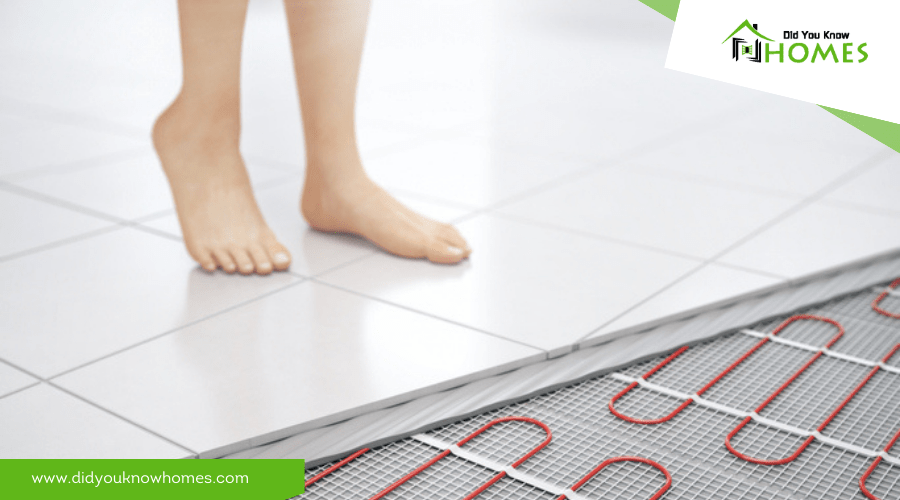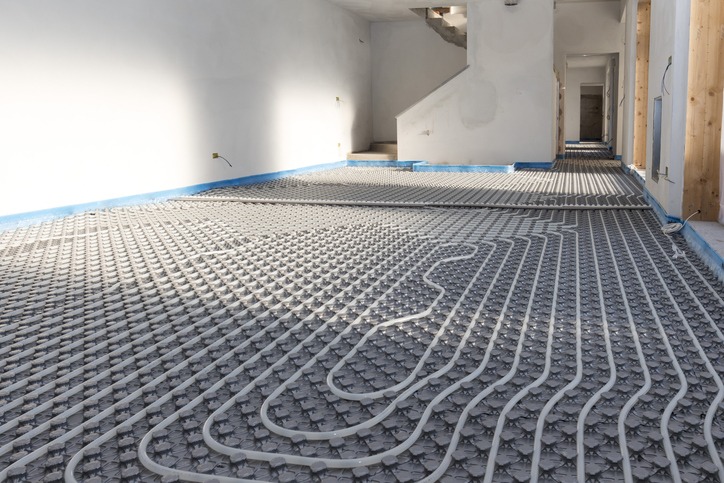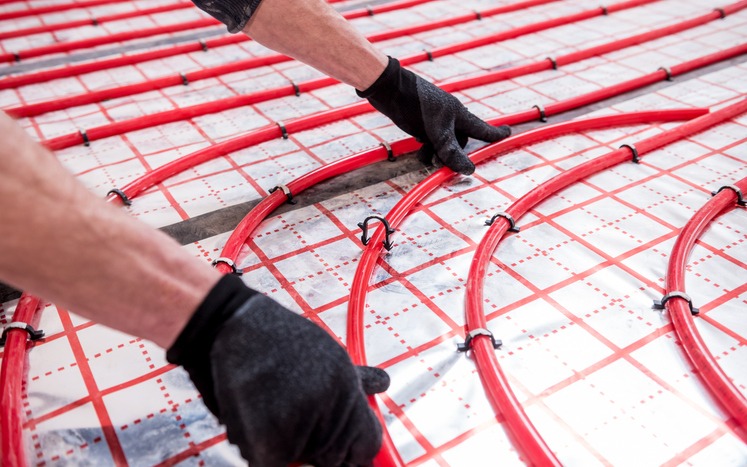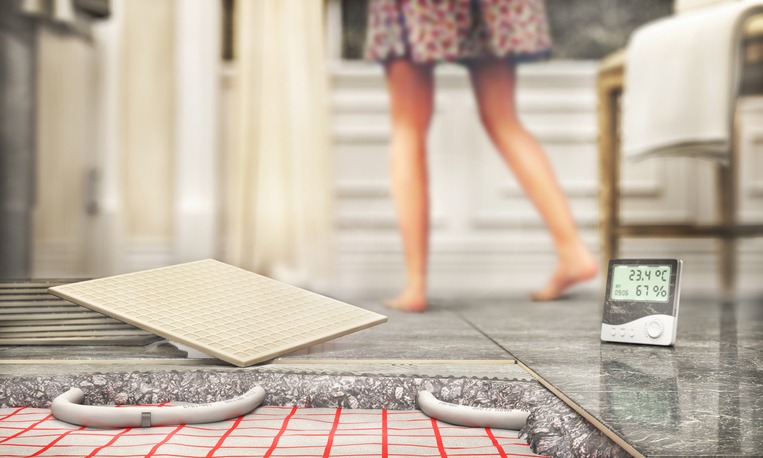You’re in for a treat with the latest in floor heating systems for your tile and stone floors. Enjoy efficient, uniform warmth that heats up quickly and stays consistent, thanks to electric and hydronic solutions. They’re designed to work beautifully under your tiles, ensuring your feet never touch a cold floor again. With smart thermostats, you can easily control temperatures and even set different zones in your home for enhanced comfort and energy savings. The installation? It’s straightforward, ensuring your system runs smoothly and efficiently. And with professional maintenance, you’ll keep enjoying that cozy warmth. Discover how these advancements can transform your home into a haven of warmth.
Key Takeaways
- Improved energy efficiency with newer radiant floor heating models reduces utility bills.
- Advanced thermostats offer precise temperature control and zone heating customization.
- Enhanced subfloor technologies ensure better heat distribution and faster warm-up times.
- Innovative installation methods simplify integration with tile and stone flooring.
- Smart system integration allows for remote control and monitoring, optimizing user convenience and energy use.
Understanding Radiant Heating
Why not consider radiant heating, a system that directly warms your floors through thermal radiation, for efficient and uniform room warmth? This method, unlike traditional heating, doesn’t rely on circulating hot air. Instead, it heats the floor itself, turning it into a large, cozy radiator. The beauty of radiant heating lies in its ability to provide consistent heat distribution across the room. This not only enhances your comfort but greatly ups the energy efficiency game.
Imagine stepping onto a tile floor that’s pleasantly warm rather than shockingly cold. That’s radiant heating for you. It’s especially a game-changer with tile and stone floors, known for their chill. These materials conduct heat well, making them ideal partners for radiant systems. You’ll enjoy not just the warmth underfoot but also lower heating bills. Radiant heating operates more efficiently than many conventional systems by focusing on heating objects directly rather than the air. This means you’re not losing warmth to drafts or the ceiling. It’s a smart, effective way to keep your space snug and your energy costs down.
Types of Radiant Systems
You’re now faced with a decision on the type of radiant system best suited for your tile and stone floors. Electric radiant systems use wires to heat up, while hydronic solutions circulate hot water beneath your feet. We’ll also guide you through the installation process, ensuring you understand every step of the way.
Electric Radiant Systems
Electric radiant systems bring the luxury of consistent, comfortable warmth to your tile and stone floors through efficient electric resistance wires. These systems aren’t just about keeping your feet cozy; they’re a smart, energy-efficient way to heat your home.
Here’s why you’ll love them:
- Quick Heat-Up Times: You won’t be waiting long for your floors to warm up, which means immediate comfort.
- Precise Temperature Control: Dial in the exact warmth you want, room by room.
- Ideal for Zoning: Heat only the spaces you’re using, saving you money on energy bills.
- Versatile Compatibility: Whether it’s tile or stone, these systems work seamlessly, ensuring even heat distribution without hot spots or cold zones.
Electric radiant systems transform your home, making every step on your floor a warm delight.
Hydronic Heating Solutions
Hydronic heating solutions offer an efficient way to warm up large spaces by circulating hot water through pipes under your floor. This system is a game-changer, especially if you’re looking to heat expansive areas without breaking the bank. Imagine stepping onto tile or stone floors that radiate a gentle, consistent warmth— that’s the magic of a hydronic system for you. It’s not just about the comfort; it’s also about being smart with your energy use. The water is heated by a boiler, making this an energy-efficient way to warm your home. Plus, the heat sticks around longer, thanks to the system’s ability to retain warmth, ensuring your space stays toasty for extended periods. With a hydronic system, you’re choosing a cost-effective, comfortable, and uniform heating solution.
Installation Process Overview
Diving into the installation process of radiant floor heating systems reveals a meticulous journey that transforms your home’s comfort and efficiency. Whether you’re leaning towards hot water radiant floors or electric radiant heating, each choice brings its unique steps and benefits:
- Subfloor preparation is important. Ensuring a clean, level base is the first step to success.
- For hot water radiant floors, installing the tubing for water circulation is key. It’s all about precise placement for even heat distribution.
- With electric radiant heating, rolling out and securing the resistance wires directly beneath your tile or stone surface comes next.
- Finally, a test run to confirm everything’s working perfectly seals the deal.
Each step is essential for a cozy, energy-efficient home.
Installation Guidelines
To guarantee your tile or stone floor heating system performs at its best, it is crucial to follow specific installation guidelines. When installing radiant heating beneath your heated tile floor, preparing the subfloor is your first step. You must ensure it is clean, level, and free of any debris that could interfere with the installation. Adhering to these guidelines not only prevents uneven heating but also shields your floor from potential damage.
| Step | Detail | Importance |
|---|---|---|
| Subfloor Preparation | Clean and level | Prevents uneven heating |
| Heating System Layout | According to manufacturer’s instructions | Ensures peak performance |
| Tile Installation | Use appropriate adhesives and materials | Maximizes efficiency and longevity |
| Testing | Before final tile laying | Avoids later issues |
Optimizing Home Zones
Now that you’ve installed your radiant floor heating, it’s time to focus on optimizing home zones for maximum comfort and efficiency. By implementing zone control efficiency, integrating smart thermostats, and applying energy-saving strategies, you’ll tailor your home’s warmth to your exact preferences while cutting down on utility bills. Let’s explore how these elements can transform your living space into a haven of personalized comfort and sustainability.
Zone Control Efficiency
Zone control in floor heating systems lets you customize temperature settings for different home areas, maximizing comfort and energy efficiency. Here’s how you can take advantage of this feature:
- Identify High-Traffic Zones: Concentrate warmth where it’s needed most, like living rooms and bathrooms, to cut down on wasted energy.
- Set Different Temperatures: Each area can have its own comfort level, ensuring everyone’s happy without overheating unused spaces.
- Schedule Heating Times: Heat rooms based on usage patterns. Warm up the bathroom in the morning and the living area in the evening.
- Monitor and Adjust: Keep an eye on how each zone performs and tweak settings for the best balance between comfort and energy use.
Smart Thermostat Integration
Integrating smart thermostats with your floor heating system revolutionizes how you manage home comfort and energy use. These smart gadgets allow for precise temperature control in different zones of your home, making it easy to optimize energy efficiency. You can program them to adjust temperatures based on specific rooms or time schedules, ensuring you’re only heating the spaces in use. This not only enhances comfort by providing personalized heating settings throughout the day but also contributes to significant energy savings. With the ability to remotely control and monitor your system via smartphone apps or voice assistants, you’ll always step into a comfortably heated environment. Smart thermostats are your ticket to a more efficient, comfortable, and energy-saving home.
Energy Saving Strategies
Building on the foundation of smart thermostat integration, optimizing home zones with energy-saving strategies can further enhance your floor heating system’s efficiency. Here’s how you’re going to do it:
- Leverage zoning capabilities: Focus on heating only the spaces you’re using. It’s not just smart; it’s cost-effective.
- Embrace programmable thermostats: Customize your heating schedule. Wake up and come home to warmth without wasting energy all day.
- Heat where needed: Direct energy to areas like living rooms or bathrooms when they’re in use. Bedrooms can wait until bedtime.
- Reap the energy savings: By tailoring your heating, you’re not just comfortable—you’re cutting costs significantly.
Simple steps, big impact. You’re optimizing comfort while maximizing energy savings. This isn’t just smart; it’s forward-thinking.
Energy Efficiency Benefits
In recent years, radiant floor heating systems for tile and stone floors have become increasingly popular, thanks to their ability to offer superior energy efficiency by directly warming objects and surfaces. These systems tackle heating differently, focusing on energy efficiency. By warming the ground beneath your feet, they guarantee the warmth is precisely where you need it, reducing the need for higher thermostat settings and, in turn, lowering energy consumption.
You’ll find that these radiant floor heating systems provide a consistent warmth from the floor up, creating an evenly heated space without the cold spots and drafts typical of traditional heating methods. This approach not only maximizes your comfort but also your energy savings, as it eliminates the inefficiency of heating unused spaces.
Moreover, the precise temperature control available with radiant heating technology means you can optimize energy use without sacrificing comfort. Whether you’re heating a small bathroom or a large living area, the system can be customized to meet the specific heating needs of each room, further enhancing overall energy savings.
In essence, radiant floor heating systems for tile and stone floors bring you the dual benefits of improved energy efficiency and tailored comfort, making them a smart choice for your home heating needs.
Design Flexibility
You’ll appreciate how the design flexibility of modern floor heating systems allows for a tailored heating experience, adapting seamlessly to various floor materials and layouts. With advancements in technology, floor heating offers not just warmth but also a customized heating solution that fits perfectly under your chosen flooring materials. Here are four key aspects where this flexibility shines:
- Customized Heating Zones: You can create zones in your home to heat specific areas to your liking, making every room cozy and comfortable. This means your bathroom can be warmer than your kitchen if that’s what you prefer.
- Compatibility with Various Flooring Materials: Whether you’ve opted for tile, stone, or another type of flooring, advanced systems cater to a wide range of materials. You won’t have to compromise on style for the sake of warmth.
- Precision Heat Distribution: The strategic placement of heating elements under the floor ensures an even distribution of heat, eliminating cold spots and enhancing comfort.
- Wi-Fi Thermostat Convenience: With Wi-Fi-enabled thermostats, you gain the power to control and customize your heating preferences effortlessly, right from your smartphone.
Embrace the future of home comfort with the unparalleled design flexibility that today’s floor heating systems offer.
Maintenance Insights
After exploring the design flexibility of modern floor heating systems, let’s focus on how keeping them in top condition maximizes their benefits. Regular maintenance is essential for ensuring your tile and stone floors remain efficiently warm and functional. You’ve got to check for any damage to the heating elements or controls, preventing minor issues from turning into costly repairs.
Cleaning your tile floors or stone tiles isn’t just about aesthetics; it plays a significant role in maintaining the efficiency of your heating system. Don’t let dust and debris compromise your cozy, warm floors. And here’s where professional maintenance services come into play. They’re your go-to experts for a thorough inspection and tune-up of your system. These pros know exactly what to look for and how to keep your system running smoothly.
Cost Analysis
Understanding the costs involved in installing radiant floor heating for your tile and stone floors is essential before making any decisions. Here’s a breakdown to help you navigate through the financial aspects:
- Installation Cost: Expect to shell out between $10 to $15 per square foot. Electric systems tend to be more budget-friendly than their hydronic counterparts, making them a go-to for many homeowners.
- Energy Savings: Don’t let the initial setup cost deter you. Over time, the energy efficiency of radiant floor heating can greatly lower your heating bills, thanks to its efficient heat distribution.
- Increased Home Value: Besides saving on energy bills, installing radiant floor heating can enhance your home’s market value. It’s an investment that pays off in the long run.
- Installation Nuances: The overall cost isn’t just about laying down heating elements. Factors like subfloor prep, precise heating cable placement, and choosing the right thermostat play critical roles in ensuring your system runs effectively and efficiently.
Frequently Asked Questions
What Is the Best Tile Floor Heating System?
The best tile floor heating system is DITRA-HEAT by Schluter® Systems. It’s energy-efficient, has smart controls, and while installation costs aren’t low, you’re getting premium quality that’ll save you money in the long run.
How Do You Heat Stone Floors?
To heat stone floors, you’ll install electric radiant heating beneath them. This method’s energy efficient, with low maintenance needs. Make sure proper installation for best warmth and durability. It’s straightforward and greatly improves comfort.
What Is the Best Stone for Heated Floors?
The best stone for heated floors depends on stone conductivity rates, installation challenges, and maintenance considerations. Granite’s high thermal conductivity and durability often make it your top choice for efficient and long-lasting heated flooring.
What Is Best Flooring for Underfloor Heating?
For underfloor heating, you’ll find tile and stone floors best due to their energy efficiency, easy installation process, and low maintenance requirements. They heat up fast and keep your space cozy without much hassle.
Conclusion
You’ve explored the world of radiant heating for your tile and stone floors, from the basics to the nitty-gritty of installation and maintenance. Embracing this technology not only amps up your home’s comfort but also boosts its energy efficiency. With a variety of systems to choose from, you can tailor your heating to fit your home’s design seamlessly. While the upfront cost might pinch, the long-term savings and luxury feel make it a smart choice. Go ahead, step into warmth.



